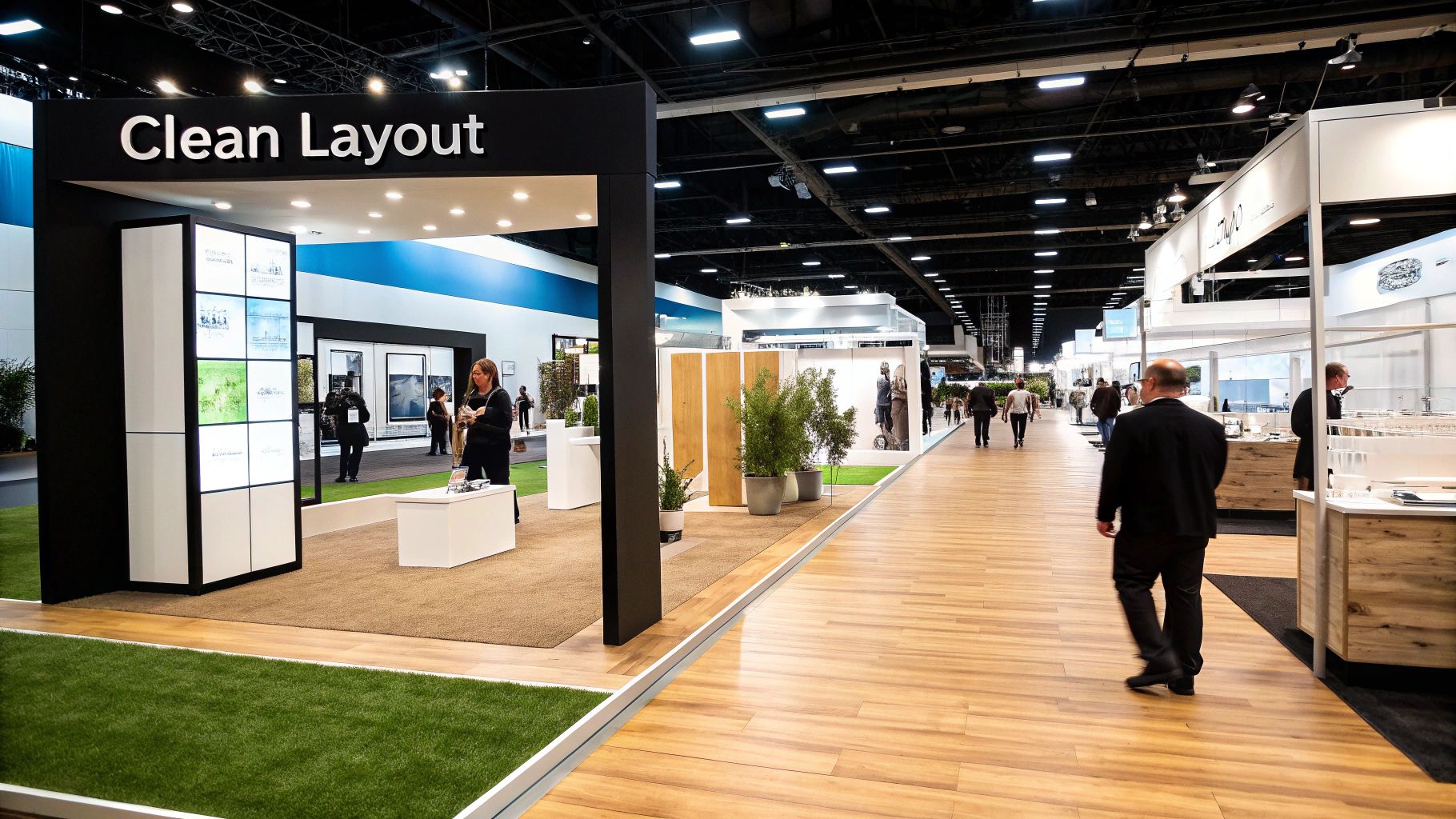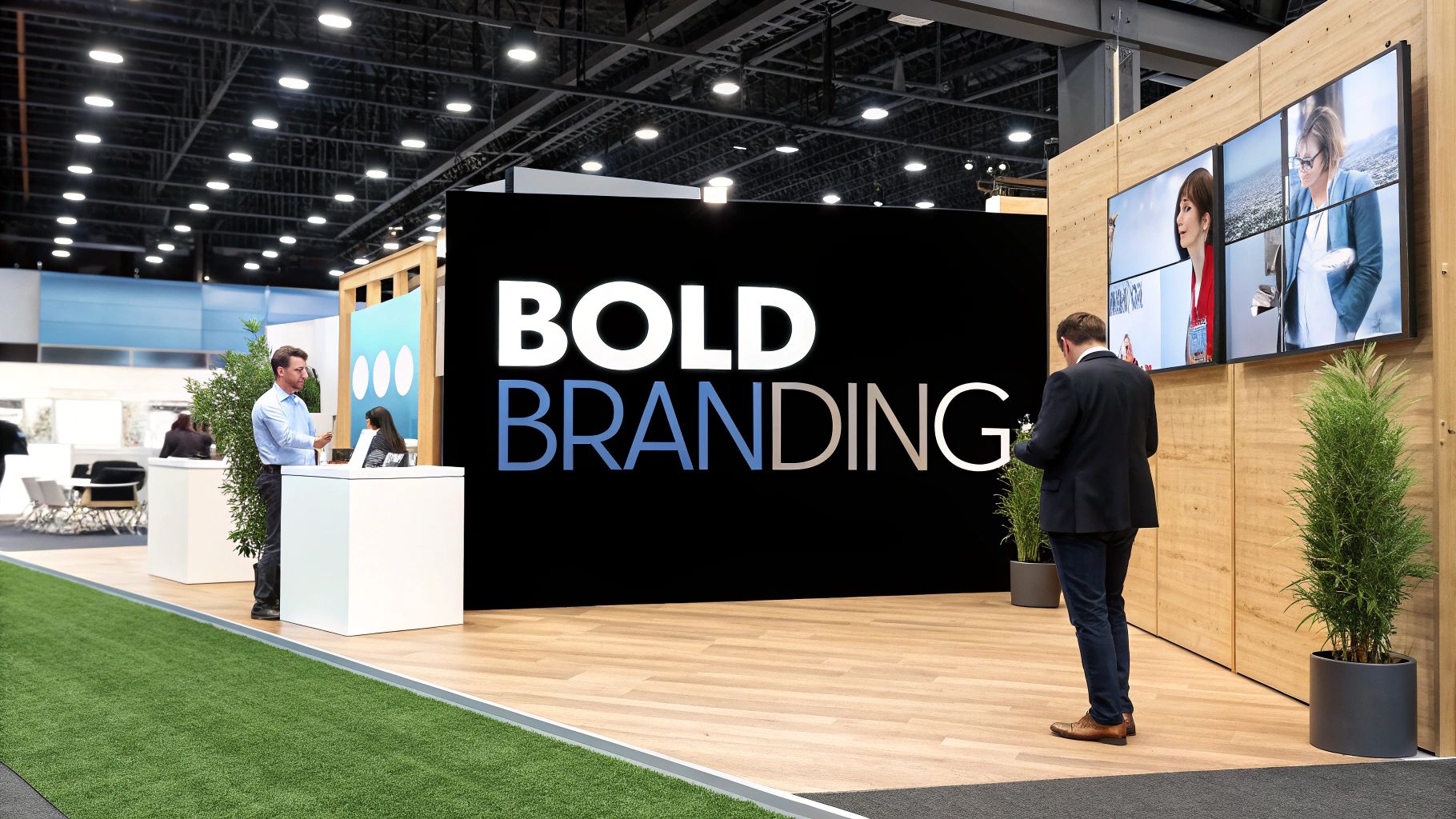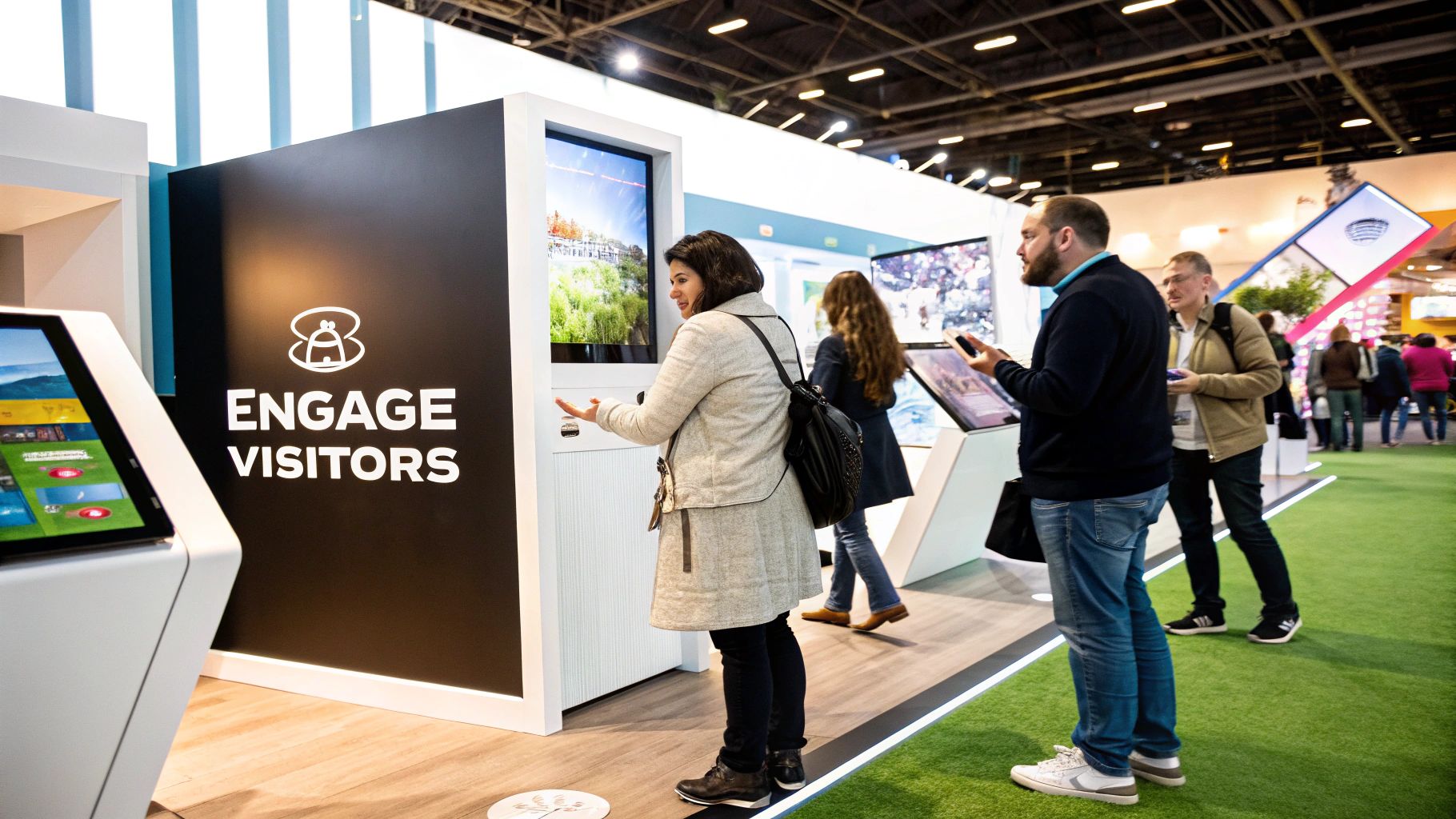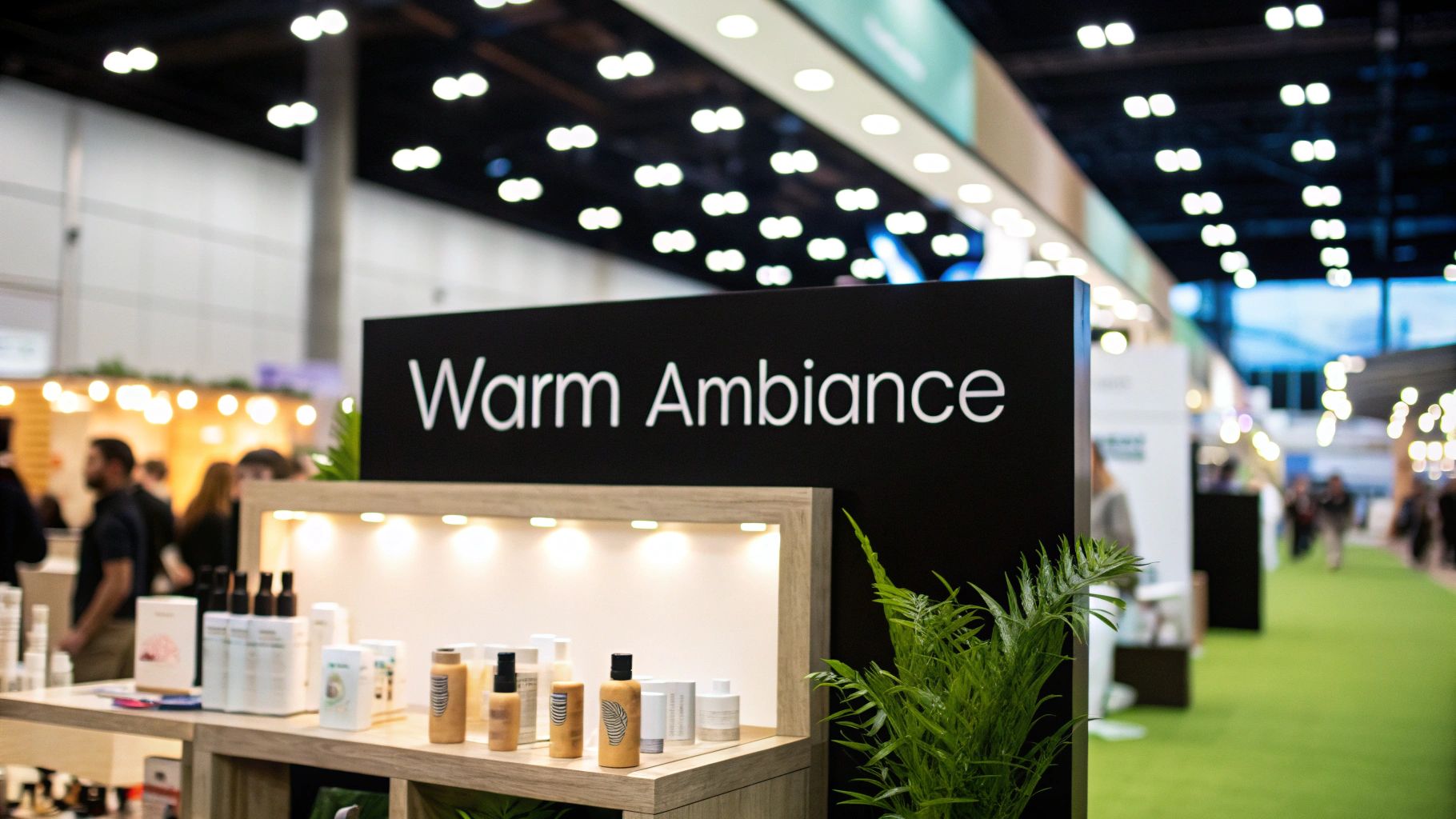Trade Show Booth Setup: Expert Tips
Strategic Planning: The Foundation of Successful Booth Setup

Turning your trade show booth into a lead-generating machine requires strategic planning well in advance of the event. This proactive approach differentiates a memorable experience from a forgettable booth. Top exhibitors begin by defining clear, measurable objectives.
These objectives might include generating a specific number of qualified leads, launching a new product, or solidifying brand positioning. A well-defined product strategy is essential. This initial groundwork informs every subsequent decision, from booth design and staff training to marketing and post-show follow-up activities.
Establishing Measurable Objectives
Defining concrete goals is the first step in successful trade show booth setup. These objectives form the roadmap for all following planning activities. Measurable goals allow you to track progress and demonstrate the return on investment (ROI) of your trade show appearance.
Before investing in your booth, identify exactly what you want to achieve. Is your focus lead generation, brand awareness, product demonstrations, or a combination? Specifying these aims early will guide your strategy and help justify the associated costs.
Setting up a booth can be expensive, with the average spend between $10,000 and $30,000 per event. Despite this, trade shows remain a vital part of B2B marketing, accounting for roughly 40% of B2B marketing budgets. The cost per lead at trade shows averages $112, significantly lower than other channels. You can find more detailed statistics here.
Crafting a Comprehensive Planning Timeline
A detailed planning timeline is crucial for experienced exhibitors. Just as a successful product launch follows a structured schedule, a well-executed trade show presence requires careful coordination. This involves securing a prime booth location, vendor negotiations, and the design and production of booth materials.
A crucial part of this process is also staff training. The timeline extends beyond logistics to include pre-show marketing efforts to build excitement and attract attendees. This pre-show buzz can significantly impact booth traffic and overall event success.
The following table provides a sample timeline to help guide your planning:
Trade Show Booth Planning Timeline Essential planning milestones for successful trade show booth setup
| Timeframe | Key Actions | Resources Needed |
|---|---|---|
| 6-12 Months Before | Define objectives, set budget, select show, book booth space | Market research, budget allocation, show directory |
| 3-6 Months Before | Design booth, order materials, plan marketing activities, arrange travel and accommodation | Design software, vendor contracts, marketing materials, travel agency |
| 1-3 Months Before | Finalize booth design, confirm logistics, train booth staff, launch pre-show marketing campaign | Production schedule, shipping information, training materials, marketing platforms |
| 1 Week Before | Ship materials, coordinate setup, finalize on-site logistics | Shipping labels, setup instructions, contact information for on-site personnel |
| During the Show | Engage attendees, gather leads, conduct product demonstrations | Lead capture tools, presentation materials, product samples |
| Post-Show | Follow up on leads, analyze results, evaluate ROI | CRM system, analytics dashboard, post-show survey |
This timeline outlines key milestones, allowing you to stay organized and manage resources effectively. Remember to adapt the timeframe and actions based on the specific requirements of your industry and the scale of the trade show.
Preparing Your Team and Resources
Successful trade show booth setup relies on effective resource allocation and team preparation. This includes the physical setup and ensuring your team is prepared to engage attendees and represent your brand.
Consider the budget for booth materials, technology, staffing, and marketing. Invest in training your team on product knowledge, lead qualification, and communication strategies. This preparation transforms your staff into brand ambassadors, maximizing your chances of converting attendees into valuable leads and customers.
Finally, integrating your trade show participation with wider marketing campaigns expands your reach and strengthens brand messaging, ensuring a cohesive and impactful presence both at the event and beyond.
Designing Your Booth to Capture and Convert Attention

In the energetic atmosphere of a trade show, your booth must not only attract attention but also effectively convert that attention into meaningful engagement. Understanding the psychology of design and applying it to your booth setup is paramount. Leading exhibitors understand this, creating spaces that draw attendees in and encourage interaction, translating visual appeal into tangible results. This strategic approach is essential for achieving your trade show goals.
Optimizing Layout for Different Booth Configurations
Whether you have a small inline booth or a large island exhibit, optimizing your layout is crucial for maximizing your impact. Think of your booth as a retail environment. Just as a well-designed store layout guides customers through the space, showcasing products and encouraging purchases, your trade show booth should guide visitors on a pre-determined journey.
- Inline Booths: For inline booths, visibility from the aisle is key. Place your most important displays and interactive elements at the front to attract passersby. A defined path leading visitors deeper into your booth can encourage further exploration and interaction.
- Island Booths: Island booths, with their 360-degree visibility, offer greater flexibility. Consider creating distinct zones for various activities, such as product demonstrations, consultations, and networking opportunities. Ensure clear sightlines and easy access from all sides.
Award-winning booths often incorporate these layout principles, creating immersive and memorable experiences for visitors. This strategic use of space is fundamental to a successful trade show presence.
The Power of Color, Lighting, and Messaging
Color psychology significantly influences how attendees perceive your brand. For example, blue often communicates trust and reliability, while orange suggests energy and innovation. Carefully select colors that align with your brand identity and resonate with your target audience. This thoughtful use of color reinforces your message and helps your booth stand out from the competition.
Lighting is equally important. Bright, focused lighting can highlight key products and displays, drawing attention to specific areas. Softer lighting, on the other hand, can create a more inviting atmosphere for conversations and networking. A well-balanced lighting scheme is crucial. Furthermore, strategic placement of clear, concise messaging is vital. Your messaging should clearly communicate your value proposition and guide visitors through the booth experience.
Trade shows continue to attract large audiences. In the first nine months of 2023, approximately 12.7 million people attended trade shows across the U.S., a 15% increase from 2022. While attendance is still 20% below pre-pandemic levels, a significant 92% of attendees actively seek new products and services. Learn more about these statistics here.
Balancing Openness and Engagement
Creating a balance between an open, welcoming environment and dedicated spaces for conversation is crucial for successful engagement. An open layout invites visitors to enter and explore your booth. Designated conversation areas, however, encourage more in-depth interactions and relationship building. This thoughtful approach to booth design maximizes your opportunities to connect with potential customers.
Consider incorporating comfortable seating, interactive displays, and charging stations to encourage attendees to stay longer and engage with your brand. These amenities create opportunities for your team to initiate conversations and build rapport with qualified prospects. This combination of accessibility and focused interaction is a hallmark of effective booth design, transforming casual visitors into valuable leads.
Essential Equipment That Transforms Empty Space Into Impact

A well-designed trade show booth attracts attention. But the right equipment transforms that attention into a memorable experience. This careful selection of key components separates a standard booth from one that truly resonates with attendees. From structural elements to interactive technology, every piece plays a crucial role. This section explores the essential equipment experienced exhibitors use to achieve their trade show goals.
Modular Display Systems: Flexibility and Impact
Modular display systems provide a versatile and cost-effective foundation for your booth. Think of them as building blocks that can be configured and reconfigured for different booth sizes and layouts. This adaptability is essential for companies attending multiple shows each year. Pilot Exhibits, for instance, specializes in lightweight, tool-free modular displays, simplifying installation. These systems offer both visual appeal and logistical practicality, minimizing setup time and drayage costs.
This inherent flexibility allows for easy updates and customization, keeping your booth looking fresh and current. Compared to custom-built booths, modular systems also offer significant cost savings, an important factor for businesses managing their trade show budgets.
Lighting and Flooring: Setting The Stage
Lighting plays a vital role in showcasing your products and creating the right atmosphere. Bright, focused lighting highlights key displays, while softer lighting can facilitate conversation. Proper lighting can dramatically improve product presentation and draw attention to specific areas. Consider your desired aesthetic and choose lighting that complements your brand and messaging.
Flooring, too, contributes to both the visual impact and functionality of your booth. High-quality flooring enhances your brand image and provides comfort for staff and visitors, particularly during long exhibition days. Pilot Exhibits offers custom-printed carpets, creating a fully branded environment that reinforces company identity.
Interactive Technology: Engaging Your Audience
Interactive technology elevates engagement, transforming passive observers into active participants. Touchscreen displays, interactive presentations, and product demos let visitors experience your offerings firsthand. This personalized interaction creates a more memorable experience, increasing the chance of converting attendees into qualified leads. These technologies also provide valuable data and insights into visitor behavior, enabling you to refine your trade show strategy.
The Rent Vs. Buy Decision
Deciding whether to rent or buy equipment is a critical aspect of trade show booth planning. Renting is a cost-effective option for businesses with limited budgets or infrequent show attendance. However, investing in quality equipment, like modular displays from Pilot Exhibits, offers long-term cost savings and allows for greater customization and consistent branding. Carefully evaluate your needs and budget to make the best choice for your business. This decision significantly impacts your overall expenses and booth effectiveness.
The Exhibition Setup Process: From Arrival to Opening

A well-designed booth and impactful equipment are essential for a successful trade show presence. However, even the best displays can underperform without a smooth setup. Mastering the logistics of booth assembly, from arrival to opening, is crucial. This section offers a detailed framework for a stress-free setup, drawing on insights from experienced exhibition managers.
Initial Space Preparation and Coordination
Upon arrival, confirm your assigned booth space and inspect it immediately for any discrepancies. Verify dimensions, power outlet locations, and pre-existing damage. This initial check prevents later surprises and allows for quick resolution of any issues with venue staff.
Coordinate with venue staff about designated loading/unloading areas and specific regulations. This early coordination can save valuable time and prevent logistical headaches down the line.
Next, organize your equipment and materials within the booth space for efficient assembly. This initial organization streamlines the construction and decoration phases, preventing wasted time and effort. A well-organized space sets the stage for a smooth and timely setup.
Managing Deliveries and Essential Services
Coordinate the arrival and placement of any rented equipment or large display items, such as those offered by Pilot Exhibits. A clear schedule and real-time communication with delivery personnel are key. This ensures each piece arrives on time and is placed correctly within your booth space.
Once the physical components are in place, secure essential services like power and internet connectivity. Test these services immediately to ensure they are functioning correctly. These utilities are vital for powering displays and enabling digital interactions. A proactive approach here prevents last-minute technical difficulties.
Time-Saving Setup Techniques From the Pros
Utilize pre-assembly strategies whenever possible. Assemble modular display components or pack smaller items in pre-organized kits before shipping. This minimizes on-site assembly time. Pilot Exhibits’ lightweight, tool-free displays can further streamline this process.
Employ efficient equipment organization methods. Clearly labeled boxes and a detailed inventory list will help you quickly locate items. This prevents the setup process from becoming a time-consuming search.
To illustrate best practices, let's look at a checklist:
Before the Table introduction add the following markdown code:
A well-structured checklist can be invaluable during setup. The following table provides a framework for a smooth process:
| Setup Phase | Key Tasks | Common Challenges | Solutions |
|---|---|---|---|
| Initial Space Assessment | Verify dimensions, locate power outlets, check for damage | Incorrect booth space allocation, missing/damaged outlets | Contact venue staff immediately, document issues with photos |
| Equipment Organization | Stage equipment and materials within booth space | Difficulty locating items, inefficient workflow | Use labeled boxes, create a detailed inventory list |
| Deliveries & Services | Coordinate rented equipment arrival, secure power/internet | Delivery delays, connectivity issues | Establish clear delivery schedules, test services immediately |
| Assembly & Decoration | Assemble displays, set up decorations | Missing components, complex assembly | Pre-assemble components, utilize tool-free displays |
| Final Checks & Adjustments | Test equipment, make final adjustments | Last-minute technical issues, unexpected delays | Have a contingency plan, maintain clear team communication |
This checklist helps address potential challenges and ensures a well-organized setup.
Team Coordination, Safety, and Contingency Planning
Maintain clear communication within your team. Regular check-ins ensure tasks are completed efficiently and challenges are addressed promptly. Coordinated action is essential for successful booth setup.
Prioritize safety protocols during setup. Use proper lifting techniques when handling heavy items and be mindful of electrical connections. This safeguards your team and prevents accidents.
Have a contingency plan for unexpected issues, such as missing components or delays. This minimizes stress and allows for a smoother experience. Planning for contingencies is especially important for first-time exhibitors.
Creating Meaningful Engagement at Your Trade Show Booth
A well-designed trade show booth is just the starting point. Attracting attendees and turning those interactions into valuable business relationships requires a strategic engagement plan. It's not just about visual appeal; it's about crafting an experience that truly connects with your target audience.
Designing Product Demonstrations That Convert
Effective product demonstrations are key to showcasing the value of your products or services in the short timeframe of a trade show. Instead of simply listing features, focus on showing how your product solves a real problem for potential clients.
For example, when demonstrating software, guide attendees through a practical use case. Highlight the key advantages and how it saves them time. A practical demonstration is far more effective than a generic sales pitch. Consider how Apple masterfully demonstrates the usability of its products in its retail stores. Apply that same principle of practical application to your booth.
Interactive Experiences: Building Emotional Connections
Interactive experiences create stronger bonds with your brand. These might include hands-on product trials, gamified product demonstrations, or personalized digital interactions. Active participation creates a more memorable impression than passively viewing static displays.
For example, allowing attendees to customize a virtual product on a touchscreen fosters a sense of ownership and excitement. This builds positive associations with your brand, increasing the likelihood of future interaction.
Creating tangible takeaways, such as branded merchandise or informative brochures, extends your booth's influence beyond the event itself. These items serve as reminders and reinforce your brand message. They also allow attendees to share their experience, organically extending your reach.
Nearly 81% of trade show attendees have buying authority, making trade shows excellent opportunities for sales generation. Attendees spend an average of 5.5 hours at these events, indicating significant engagement and potential for meaningful interactions. For more detailed statistics, see Expo Display Service.
Empowering Your Staff Through Effective Training
Your booth staff represents your brand at the event. Giving them the knowledge and tools to qualify prospects efficiently is critical. This means training them on product specifics, target audience characteristics, and strong communication techniques.
Your team needs to quickly identify qualified leads and tailor their approach accordingly. Consistent messaging across all staff ensures a unified and professional image, significantly impacting the perception of your company and its products.
Optimizing Traffic Flow and Lead Capture
Your booth's physical layout plays a major role in traffic flow. An open and inviting design encourages exploration. Strategic placement of displays and interactive elements can guide attendees through a planned journey. This thoughtful design boosts engagement and ensures visitors see your key offerings.
Integrating a solid lead capture system is essential for converting conversations into actionable data. This could involve using lead retrieval scanners, digital forms, or interactive kiosks. A well-designed system allows for efficient data collection and simplifies post-show follow-up, bridging the gap between initial interest and long-term customer relationships.
Effective follow-up is the final element of successful engagement. Timely, personalized communication after the event strengthens connections and nurtures leads. This may include sending targeted emails, scheduling product demonstrations, or offering exclusive post-show discounts. This continued engagement maximizes the return on your trade show investment.
Maximizing ROI: Post-Event Analysis and Optimization
The conclusion of a trade show isn't the end; it's the beginning of post-event analysis. This involves dismantling your booth, preserving equipment, and evaluating your performance. This provides key insights for future trade show appearances and overall marketing strategies.
Streamlining Dismantling and Equipment Preservation
Efficient dismantling is as important as efficient setup. A systematic approach protects your investment in trade show booth materials and equipment, ensuring they last for future events. This means carefully inventorying components, disassembling displays, and packing them securely. Proper packing prevents damage and makes setup easier next time.
For example, Pilot Exhibits' modular display systems are designed for easy dismantling and compact storage. Their lightweight design simplifies handling and reduces drayage costs, maximizing your initial investment. This practicality highlights the long-term benefits of quality, reusable displays.
Data-Driven Performance Evaluation
Analyzing your performance against pre-determined objectives is crucial for understanding your ROI. This includes assessing lead quality, calculating customer acquisition cost (CAC), and analyzing your competitive landscape. This data reveals what worked with your audience and what needs improvement.
Go beyond simply counting leads. Assess their quality – engagement, purchase intent, and alignment with your target audience – for a more accurate measure of success. This deeper analysis improves follow-up efforts and conversion rates.
Calculating your CAC at the trade show reveals the cost-effectiveness of this marketing channel. Compare it to other avenues to optimize future campaign resource allocation. This data-driven approach ensures you maximize your marketing budget.
Lead Nurturing and Long-Term Growth
Post-show lead nurturing turns initial interest into business outcomes. This means prompt, personalized follow-up, offering relevant information, and building relationships. This continued engagement keeps your brand top-of-mind and improves lead conversion.
This might include targeted email campaigns, product demonstrations, or exclusive post-show discounts. This personalized approach shows your commitment to building relationships and reinforces connections made at the event. This ongoing dialogue maximizes your trade show investment.
Effective post-event analysis optimizes future trade show appearances. By analyzing successes, identifying areas for improvement, and making changes, you can refine your strategy. This continuous improvement ensures your investments yield increasingly valuable returns, contributing to sustained growth.
Ready to improve your trade show presence? Explore Pilot Exhibits' premium modular displays at https://pilot-exhibits.com and make your next event a success.





